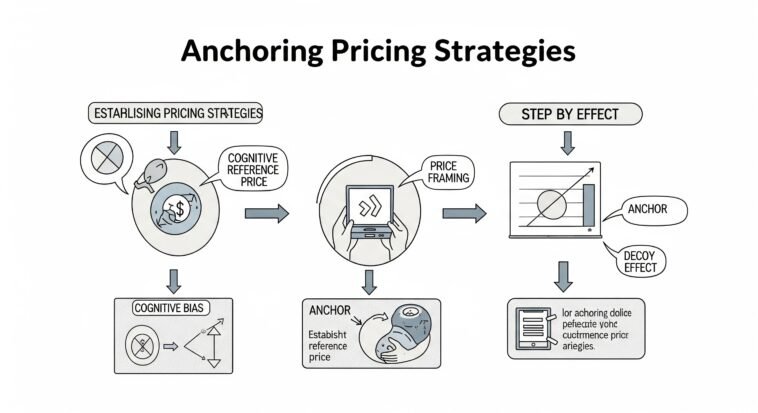
Anchoring is when people fixate on the first number they see—like seeing a $2,000 laptop makes the $1,300 one look like a steal.
Big brands like Apple and Amazon use this trick all the time.
It’s not just psych theory—it’s smart pricing strategy.
If you’re setting prices and want better sales, learn to anchor.
Whether you’re launching your first product or fine-tuning your funnel, this move can seriously level up your revenue game.
Understanding the Anchoring Effect: The Psychology Behind Pricing Decisions
The anchoring effect is a brain glitch discovered by Kahneman and Tversky (aka the Beyoncé and Jay-Z of behavioral economics).
Basically, once your brain sees a number—any number—it latches on.
That first price becomes your “mental yardstick,” even if it has nothing to do with what the thing’s actually worth.
So if you see a $3,000 handbag, then a $700 one, your brain’s like, “Wow, what a deal!”
That’s anchoring.
It works on everyone, even when the first number is totally random.
Yep—your brain can get tricked by a lucky spin on Wheel of Fortune.
For businesses, this is huge.
Use smart price anchors and suddenly your $99 product feels like a steal next to a $199 version.
Done right, anchoring boosts sales, average order size, and perceived value—all without changing your actual product.
But there’s a catch: you gotta use it ethically. No shady bait-and-switches. Just smart framing that helps customers see the value.

Types of Anchoring in Pricing Strategies
Not all anchors are the same.
Here are three ways businesses use anchoring to guide your brain (and your wallet):
External anchoring
This is the Jedi mind trick where you show a big price before your actual offer.
Restaurants do it with expensive wines at the top of the list so that $40 bottle feels chill.
Online shops love it too—ever see “Was $129, Now $59”? Boom. Anchored.
Amazon, fashion sites, SaaS landing pages—they all use this.
Your brain sees the high number first, and suddenly the “real” price looks like a win, even if it’s still high.
Internal anchoring
This one’s about how you lay out your pricing.
Think: good, better, best. That “best” option?
It’s not always meant to sell—it’s there to make the “better” one look like the smart move.
Apple nails this.
Drop the ultra-premium model first—$1,599 iPhone with all the bells—and suddenly the $999 version feels like a deal, even though it’s still way up there.
It’s all about context.
Decoy pricing
This is where you throw in a price just to steer people where you want them to go.
It’s the movie theater move:
- Small popcorn = $3
- Medium = $6.50
- Large = $7
Who’s buying the medium? No one.
But it makes the large feel like a steal. That’s decoy pricing.
You create a “meh” option to make your preferred one look golden.
Implementing Anchoring Techniques Across Different Industries
Anchoring isn’t just for fancy wine lists and Apple keynotes.
It shows up everywhere—from online stores to SaaS dashboards—and when done right, it seriously moves the needle.
Retail and e-commerce
Online stores go all-in on anchoring.
You’ve seen it—original prices crossed out next to “limited-time” deals.
That high number sticks in your brain and makes the sale price feel like a win.
Simple, but it can boost conversions by 20–30%.
Subscription boxes? They play it smart.
Show the full annual price first ($240/year), then break it down ($20/month).
Suddenly, $20 a month sounds way more doable—and people are more likely to commit long-term.
Service-based business strategies
Marketing agencies, coaches, consultants—they all use anchoring in their pricing proposals.
Classic three-tier setup:
- Starter (bare bones)
- Pro (sweet spot)
- VIP (fancy, rarely chosen)
That top-tier “VIP” package? It’s often just there to make “Pro” look like a logical, budget-friendly choice.
It’s the business version of ordering the medium popcorn.
Consultants also anchor by casually dropping their biggest success stories or premium engagements in conversation.
Once your brain hears “$10K strategy project,” the $3K retainer doesn’t sound so wild.
SaaS and technology
SaaS companies basically live off anchoring.
Their pricing pages always lead with the big-ticket “Enterprise” plan, then drop down to mid-tier and basic options.
That high anchor makes $49/month look pretty chill.
They also highlight premium features first—unlimited users, integrations, priority support—so that when you pick the standard plan, it still feels robust, not stripped-down.
That keeps customers happy and ups conversion.

Best Practices for Ethical Anchoring Implementation
Anchoring works, but only if you keep it real. If you fake it—like throwing up random “was $499” prices or inventing scarcity—you’ll burn trust faster than a Fyre Festival promo.
Transparency and value communication
Anchoring isn’t magic—it just helps customers see value more clearly.
But that only works if the product actually delivers.
Don’t mark something up just to slash it down later.
That’s how you end up in Reddit threads about scammy pricing.
Instead, highlight why your price makes sense. Show real comparisons.
If you’re stacking up against a competitor, be honest. Anchoring should guide, not manipulate.
Testing and optimization strategies
Anchoring isn’t one-size-fits-all. A/B test like it’s your job (because, well… it is). Try:
- Changing the order you show prices
- Testing different “compare at” anchors
- Playing with package layouts (3-tier vs. bundles)
Watch your numbers—conversion rate, average order value, and customer lifetime value. Those are your scoreboard.
Pro tip: Small tweaks (like just switching the order of pricing cards) can unlock big wins.
Avoiding common anchoring mistakes
If your anchor price is way too high, it backfires.
Customers don’t think, “Wow, great deal!”—they think, “Who do they think I am? Jeff Bezos?” You want the anchor to feel aspirational, not delusional.
The sweet spot? Usually 20–40% above your target price. Enough to set a frame, not enough to trigger a rage-quit.
Keep anchoring consistent everywhere
Your anchor game needs to match across your website, email, ads—everywhere.
If your homepage shows one price stack and your sales deck shows another, people will get suspicious. And confused brains don’t convert.
Measuring the Impact of Anchoring Strategies
Anchoring feels smart, but how do you know it’s working? Easy: track what people do after seeing your prices—not just what they say.
Key performance indicators
Here’s your anchoring scoreboard:
- Average Order Value (AOV) — Are people spending more per order? That’s anchoring doing its thing.
- Conversion Rate — Are more folks clicking “buy”? That’s the goal.
- Product Mix Shift — Are people picking your mid- or high-margin options more often now? That’s the “good, better, best” magic kicking in.
- Customer Acquisition Cost (CAC) vs. Lifetime Value (LTV) — If AOV goes up and your CAC doesn’t spike, congrats—you’re winning.
If people are spending more without costing you more to acquire? That’s the sweet spot.
Analytics and data interpretation
Heatmaps (shoutout to Hotjar or Crazy Egg) show where people click and scroll—so you can see if they even look at that fancy premium anchor.
Conversion funnels tell you where they bounce.
If they always drop off at the high-priced plan, maybe the anchor’s too spicy.
Cohort analysis? That’s next-level.
Use it to check if people who respond to anchoring stick around, buy more later, or peace out after one purchase.
Don’t trade quick wins for long-term trust.

Conclusion: Leveraging Anchoring for Sustainable Growth
Anchoring is one of the best tools in marketing.
Use it right, and you can boost revenue and help customers feel like they got a great deal.
But it only works long-term if you’re honest and know your audience.
Test it. Tweak it. Keep it rooted in real value.
The brands that anchor with brains and ethics win big—especially in noisy markets where trust matters.
Consumer habits will change. Tech will evolve.
But how our brains process prices? That’s not going anywhere.
So whether you’re revamping your pricing page or launching your next product—anchor smart, not shady.



